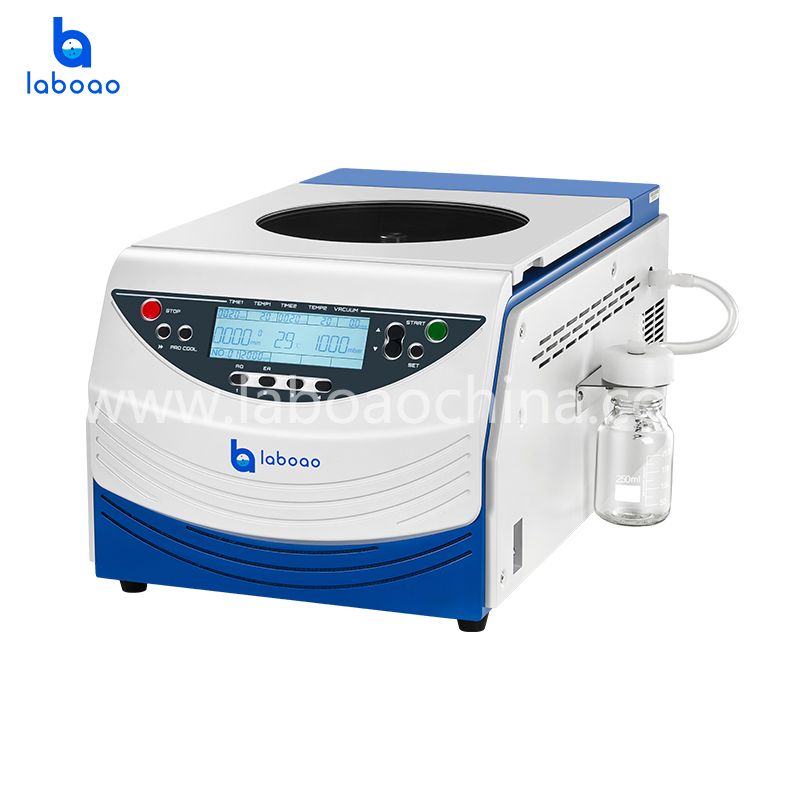Application And Value Of Vacuum Centrifugal Concentrator
1. The vacuum centrifugal concentrator consists of six parts: controller, turntable and rotating head, centrifuge tube, vacuum system, heating device, display and alarm system. By adjusting the centrifugal time and centrifugal speed, different liquids are separated, thereby achieving solvent evaporation and sample concentration. In addition, in the four key steps of centrifugal separation, vacuum evaporation, heating assistance, monitoring and control, we need to follow certain procedures and precautions: Before use, the equipment needs to be fully inspected to ensure that all components are tightly connected and there is no leakage. During use, the speed, temperature, vacuum degree and other parameters should be reasonably set according to the sample characteristics and experimental requirements, and attention should be paid to the operating status of the equipment and the concentration of the sample. After the experiment, the equipment should be cleaned and maintained in time to ensure its long-term stable operation.
2. In the rapidly developing scientific research and industrial production, the efficiency of experimental equipment has become an important force to promote innovation. Among them, the vacuum centrifugal concentrator has become a powerful assistant in modern laboratories with its functions and advantages.
(1) Functions and advantages
Main functions:
1) Efficient concentration: quickly remove solvents and increase sample concentration.
2) Sample protection: Mild operating conditions preserve sample activity to the greatest extent possible.
3) Precise control: Precisely control centrifugal force and temperature to ensure concentration effect.
Advantages:
1) Efficient and fast: Significantly shorten the experimental cycle and improve work efficiency.
2) Wide range of applications: Applicable to a variety of samples and solvents.
3) High degree of automation: Reduce manual intervention and reduce operating errors.
4) Safe and reliable: Work under vacuum conditions to avoid sample contamination and volatile leakage.
(2) Accelerator of scientific research efficiency
In a fast-paced scientific research environment, time is productivity. Centrifugal concentrators, with their efficient sample processing capabilities, have become a powerful assistant to improve scientific research efficiency. Whether it is DNA/RNA extraction and protein purification in molecular biology experiments, or sample pretreatment in drug development, they can significantly shorten the experimental cycle by quickly removing solvents or separating components. This "plug and play" convenience allows scientists to devote more energy to experimental design and data analysis, accelerating the output of scientific research results.
(3) Guardian of sample protection
For precious biological samples or active molecules, every step of the processing process must be treated with caution. During the concentration process, gentle physical means are used to avoid the influence of adverse factors such as high temperature and light on the activity of the sample, effectively protecting the integrity and biological activity of the sample. This feature is particularly important in research that requires maintaining the original characteristics of the sample, such as the screening of active pharmaceutical ingredients and the concentration of cell culture fluids, providing a strong guarantee for the in-depth progress of scientific research.
(4) Navigation of experimental results
Every step of scientific research pursues precision and reliability, and its precise concentration ratio and controllable operating environment are the escort for experimental results. In quantitative analysis, accurate control of the sample concentration ratio is crucial to the accuracy of the data; and in research that requires strict control of experimental conditions, the stable working environment provided becomes the key factor for the success of the experiment. These advantages make it a trusted experimental partner for scientific researchers, helping them find the right direction in a complex and changing experimental environment.
(5) Bridge for multi-field applications
The wide application of this equipment is not limited to a specific field, but spans multiple disciplines such as biological sciences, medicine, and environmental sciences. In biological sciences, it helps cutting-edge research such as gene sequencing and proteomics; in the medical field, it helps scientists quickly extract key components from pathological samples, providing strong support for disease diagnosis and treatment; and in environmental sciences, it is used for the pretreatment of environmental samples such as water and soil, contributing to environmental monitoring and pollution control. This cross-domain adaptability demonstrates its strong vitality as a scientific research tool.
3. Conclusion
As one of the important equipment in modern laboratories, the vacuum centrifugal concentrator plays a role in scientific research and industrial production with its efficient sample processing capabilities, meticulous protection of samples, navigation of experimental results, and a wide range of multi-field applications. With the continuous advancement of science and technology and the increasing diversification of experimental needs, it will shine in more fields, provide more powerful support for human scientific exploration and technological innovation, and become an important force in promoting scientific progress.


